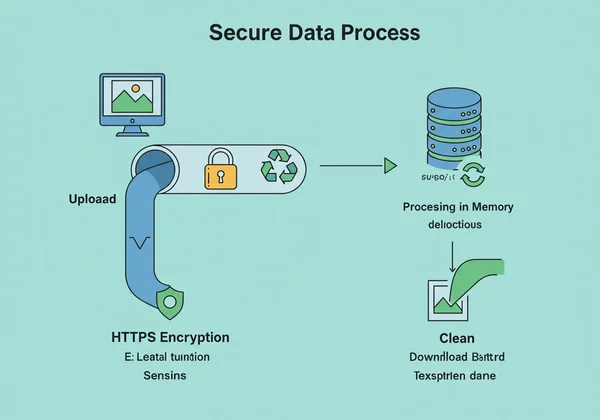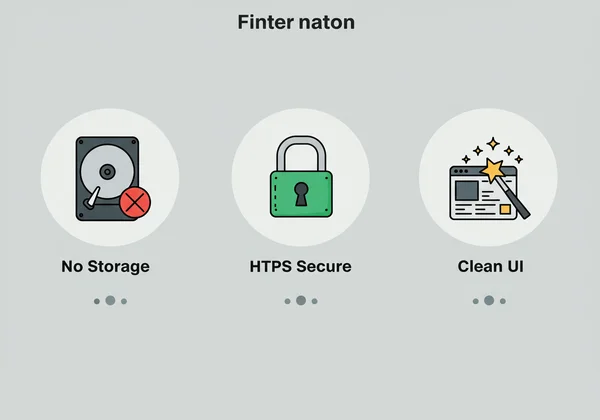Secure Metadata Removal: Are Online Tools Really Safe?
Sharing photos online is second nature, but every picture could be revealing more than you think. But what if every picture you post online carries a hidden digital footprint, revealing your location, your device, and when you took the photo? The solution seems simple: use a secure metadata removal tool. Yet, this presents a new dilemma. To protect your privacy, you have to upload your personal photos to an online service, which can feel like a leap of faith. The crucial question you’re likely asking is, is it safe to remove metadata online?
This article will demystify the security of online privacy tools. We'll explore the real risks of untrustworthy services and provide a clear framework for identifying a safe platform. Most importantly, we will show you exactly how our tool is engineered from the ground up for your security, so you can remove photo metadata with total confidence.
Understanding the Risks of Unsecure Online Privacy Tools
Not all online tools are created equal. While many services offer to strip EXIF data from your images, the way they operate behind the scenes can vary dramatically. Using an unsecure or poorly designed tool can expose you to the very privacy risks you’re trying to avoid. Understanding these dangers is the first step toward making an informed choice.
The Dangers of Data Logging and Image Storage
The most significant risk associated with subpar online tools is their data handling practices. Some services may secretly engage in data logging, recording your IP address, browser information, and the times you use their service. Worse, they might practice image storage, keeping a copy of every photo you upload on their servers indefinitely. This creates a treasure trove of personal data that could be sold, misused, or compromised in a data breach. Imagine your private family photos being stored on a server you know nothing about, accessible to unknown parties.
Privacy Policy Red Flags to Watch Out For
A company’s privacy policy is its promise to you. However, many are intentionally vague or filled with legal jargon. When evaluating a privacy policy, watch for red flags. These include broad clauses that grant the service a license to "use, host, store, reproduce, modify, [or] create derivative works" from your content. If a policy is difficult to find, hard to understand, or suggests your data is a commodity, it's a clear signal to proceed with extreme caution. A trustworthy service will have a clear, concise, and easily accessible policy that explicitly states what it does—and does not do—with your files.
Why "Free" Tools Can Come at a High Cost
The old saying, "If you're not paying for the product, you are the product," often holds true for "free" online services. Running servers and maintaining software costs money. If a tool is offered for free with no clear business model, you must question how it stays afloat. The cost is often hidden. It could be through selling user data, displaying intrusive and potentially malicious ads, or storing your images for other purposes. A truly secure and free metadata cleaner should prioritize user privacy over profit.

Our Commitment to Your Photo Data Security
We believe that privacy is a right, not a feature. We built our service on a foundation of trust and transparency, addressing the core security concerns that users rightly have. Our commitment to photo data security isn’t just a marketing promise; it’s embedded in the very architecture of our tool. We want you to feel empowered and safe every time you clean your images.
How We Handle Your Photos: Our No-Storage Promise
This is our most important commitment to you: we have a strict no-storage promise. When you upload an image to our tool, it is processed in memory, the metadata is stripped, and the clean image is made available for you to download. The original file and the processed version are never saved to our servers or any permanent storage. Once your session is over, the data is gone forever. We don't want your photos, and we have designed our system to ensure we never keep them.
Explaining Our Secure Process (Client vs. Server-Side)
To guarantee your privacy, we employ a highly secure process. Much of the metadata removal can happen directly in your browser (client-side processing), meaning your image may not even need to be uploaded to our server at all. For file types that require server-side handling, the file is sent over an encrypted connection, processed instantly, and then immediately deleted. This hybrid model ensures both speed and maximum security, as your file’s exposure is minimized to the few seconds it takes to erase exif data.

Why We Don’t Require Registration or Personal Info
Simplicity and security go hand in hand. We don’t require you to create an account, provide an email address, or share any personal information. Why? Because the safest way to protect user data is not to collect it in the first place. By eliminating the need for registration, we remove another potential privacy risk. You can use our secure exif remover anonymously, reinforcing our core principle of protecting your identity.
How to Vet Any Secure Metadata Removal Service
Being empowered means having the knowledge to make safe choices anywhere online. Beyond using our tool, we want you to be able to identify any trustworthy service. Evaluating a secure metadata removal service doesn't have to be complicated. By focusing on a few key indicators, you can quickly determine whether a tool is designed to protect you or exploit your data.
A 3-Step Checklist for Evaluating Online Tools
Before uploading a photo to any new online tool, run through this simple checklist:
-
Check for a "No-Storage" Policy: Look for a clear, prominent statement confirming that your files are not stored. If you can't find one easily, assume the worst.
-
Verify the Connection is Secure: Always check for "HTTPS" and a padlock icon in your browser's address bar. This ensures your connection to the site is encrypted.
-
Assess the User Experience: Is the site clean and professional, or is it cluttered with aggressive ads and pop-ups? A trustworthy service like an online metadata remover prioritizes a seamless, secure user experience.

Understanding Security Certificates (HTTPS)
The "S" in HTTPS stands for "Secure." It means that all data transferred between your browser and the website’s server is encrypted and authenticated. Without HTTPS, any data you send—including your photos—could potentially be intercepted by third parties. Think of it as a digital seal of authenticity and privacy. Never use a privacy tool that doesn't use HTTPS, as it fails at the most basic level of security certificates.
The Importance of a Clear, Simple Interface
A website's design can be a surprising indicator of its trustworthiness. A clear, simple, and professional interface suggests that the developers have focused on functionality and the user. Conversely, a website littered with distracting advertisements, confusing navigation, or pop-up windows often indicates that the primary goal is to generate revenue, potentially at the expense of user privacy. A tool designed for privacy should feel clean, direct, and respectful of your attention. When you need to strip exif data, the process should be straightforward.
You now have the knowledge to distinguish safe privacy platforms from dangerous ones. Our tool was built with these principles of security and trust at its core. With a strict no-storage promise and no registration required, you can take control of your digital footprint with absolute peace of mind.
Ready to protect your privacy without compromise? Drag and drop your photo on our homepage now to experience truly secure metadata removal. Try MetadataRemover.org for Free
Frequently Asked Questions About Online Photo Safety
Is it safe to remove metadata online?
Yes, it is safe, provided you use a trustworthy tool built on a foundation of security. A safe service will use HTTPS encryption, have a clear no-storage privacy policy, and not require personal information. Always vet a tool using the 3-step checklist mentioned above before uploading any images.
What can photo metadata reveal about me?
Photo metadata, or EXIF data, can reveal a surprising amount of personal information. This can include the exact GPS coordinates where the photo was taken (your home, a school, or a vacation spot), the precise date and time of the picture, and details about the specific camera or smartphone you used, which can be used to identify you.
Why should I remove metadata from my images?
You should remove metadata to protect your personal privacy and security. Removing location data prevents strangers from knowing your whereabouts. For professionals, it protects client confidentiality and creative techniques. For companies, it’s a crucial step for data compliance with regulations like GDPR, preventing accidental leaks of sensitive information.
Does your service store my photos?
No, absolutely not. Our tool operates on a strict no-storage promise. Your images are processed in real-time and are never written to a disk or stored on our servers. The moment you close your browser session, any trace of the file is gone. We built our meta cleaner to ensure your privacy is always protected.